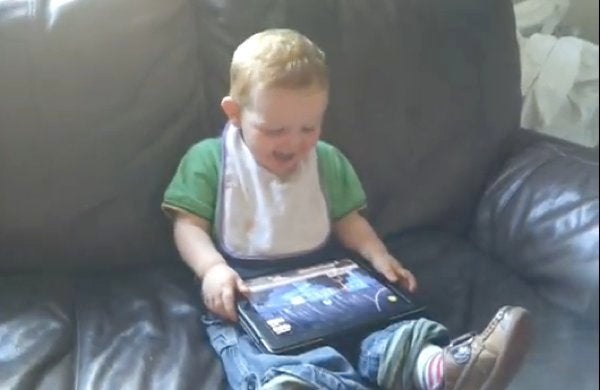
Today's young children, from birth through age 8, are spending an average of two hours and 16 minutes with screen media on a typical day. More than a quarter of their screen time comes from playing on computers, videogame consoles, cell phones and iPad-like tablets. The average age for first-time use of a computer is around 3-and-a-half years old.
These are among the results released today from a survey of more than 1300 parents from around the country. The findings are part of Zero to Eight: Children's Media Use in America, a report by Common Sense Media, a non-profit organization that runs a website that reviews movies, games and other media aimed at children. The report follows up on surveys conducted several years ago by the Kaiser Family Foundation.
Anyone who has watched YouTube videos of babies playing with iPads will probably be a little unsatisfied by the new statistics. What about e-books for kids? Skype sessions with Grandma? If "edu" apps on iPads qualify as screen time, does it help that Moms and Dads are usually interacting with their children at the same time that their tots are pressing their pudgy fingers against the screens? Today's new data do not go deep enough to answer these questions.
But the snapshot offered by today's data -- as well as similar statistics from the Always Connected report by the Joan Ganz Cooney Center at Sesame Workshop -- is useful for putting some parameters around what we know and what we don't about how media fits into kids' lives. And it may prompt some interesting questions about intersections between socio-economic status, families' screen routines, and how children are exposed to the building blocks of literacy.
Consider the data on reading. Parents were asked to think about "yesterday" and mark on the survey how much time their children spent doing various activities, one of which was "reading or being read to." The results show that 70 percent of young children watch TV on a TV set, while 69 percent read or are read to each day. You might think: So far, so good. Those numbers are pretty much identical. But then consider what the flip of this means: On a typical day more than 30 percent of children in this age group are not getting the experience of reading or being read to. That's nearly one in three children who are not exposed to books on a typical day. (I'm assuming that this could include books on screen, since the survey simply asked about "reading.") Given what research has taught us about the importance of daily exposure to reading for a child's reading comprehension and fluency in later years, and given the worrisome reading achievement gaps in the United States, this number should give us pause.
The number of minutes spent reading is also worth dwelling on. In 2003, the Kaiser Family Foundation asked parents the same question, though it included children from six months of age to 6 years of age, instead of from 0 to 8. So the Common Sense Media survey results were broken down to enable comparisons over time within that age range. The results showed that in 2003, young children were "reading or read to" for 39 minutes a typical day. In 2011, that number fell to 29 minutes a day. What is happening in the lives of families that is leading to that drop off?
Looking at race, ethnicity and socioeconomic status, the statistics tell a more complicated, and perhaps surprising, story. Of children up to age 8, African American children spend more time with media of any kind than white children do. They watch about 30 minutes a day more watching TV, but they also spend 13 minutes more reading or being read to each day than white children. Their total reading time is about 41 minutes a day, according to the study. Hispanic children spend far less time reading or being read to: 25 minutes, according to the study. (Other differences by race have been found in a study published last spring by Northwestern University that looked at data on older children and adolescents.)
In the Common Sense Media data, differences in income and parent education do not appear to have as significant an effect on reading time as one might think. While parents making less than $30,000 a year reported 40 more minutes of TV time compared to those making more than $75,000 a year, the number of minutes their children spent reading or being read to was only a few minutes lower for the lower-income parents. The same goes for comparisons between parents with a high-school diploma or less compared to parents with a college degree or more.
As with any survey in which parents are reporting on themselves, all numbers should be taken with a grain of salt. Some parents may have felt it was more socially acceptable to report high numbers for reading or low numbers for TV, for example.
As analysts and experts parse the data in the months and years to come, new twists may emerge. But the larger picture painted by today's statistics is hard to miss: Media is embedded in children's lives and dominating hours of their days, while reading is trailing behind. The next trick is to tease out what I call the Three C's: the content, context and the individual child. What kinds of media -- what TV shows, which online games? Who's with them as they read and play, and how is that experience integrated into what they are learning or interested in? And what ages and dispositions of children are drawn to what kinds of media for what reasons? Until we can answer these questions, we will continue to be in the dark about the impact of media and its complicated connection to literacy among the next generation.